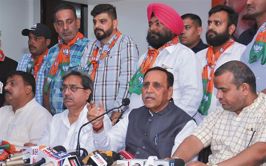
UNDER SCRUTINY: Top Indian spice brands are in the crosshairs of food regulators over alleged contamination. Reuters
Science Commentator
THE food regulator of Hong Kong recently suspended the sale of three spice blends manufactured by an Indian company. This was followed by a similar action against another Indian spice brand in Singapore. The regulatory action came after the detection of high levels of ethylene oxide, a carcinogen, in the spices exported from India. The Maldives, too, has taken such action, while the US Food and Drug Administration (FDA) and the Australian food authority are examining the reports of contamination.
The FSSAI should make public the ‘conflict of interest’ data of members of all rule-making panels because consumers should know who is setting the standards.
This is nothing new. Several hundred shipments of spices from India are refused entry for not meeting the quality norms in the US every year. Ayurvedic formulations are often red-flagged by the FDA and other regulators for containing excessive amounts of lead and other harmful heavy metals. Sometimes, the reverse also happens, as in the recent case of food company Nestle, which was found marketing baby foods with high sugar content in India, but not in markets in developed countries.
All these episodes follow a familiar pattern. The companies involved, be they Indian or multinational, deny any wrongdoing. They claim they are following the prescribed safety standards either in the country of origin or where they are exporting to, based on what suits them. The standard response of Indian regulatory authorities is that they are ‘studying the situation’, besides blaming foreign regulators for not sharing test reports with them.
The export promotion agencies and industry bodies play the victim card — they argue that Indian exports are being singled out by Western countries which want to tarnish India’s image. Such statements are supported by ministries and ministers concerned, in the name of the ‘Make in India’ dictum. Multinationals blamed for marketing potentially harmful products in India justify themselves by saying they are only following the standards laid down in India. In all this, the consumer remains a hapless spectator. For all the rest, it is business as usual once the din dies down.
No effort is made to address the issues at the crux of such episodes — loopholes in the food regulatory system like the opaque process of developing standards and rule-making, the near-absence of Good Manufacturing Practices, lax enforcement of standards and regulations and an inadequate analytical and testing system. The other important issues are governmental protection of the industry in the name of boosting export and discouragement of the representation of public health, consumer and civil society experts in food regulation.
Food companies involved in controversies wriggle out by saying they are following standards fixed by the Food Safety and Standards Authority of India (FSSAI), as has happened in the recent case of Nestle. Therefore, the method of fixing standards is critical. The FSSAI has a set of 26 scientific committees to provide inputs for setting standards for food products ranging from beverages to marine products. When the authority was formed in 2008, it packed these scientific panels with representatives of Indian and global food companies. Following an outcry in the media, courts and Parliament, the panels were reconstituted. Subsequently, too, food companies continued to dominate through industry chambers and associations, which were given a seat on the scientific panels.
A few years later, this changed, and now the panels have working and retired scientists. Still, one can’t say confidently that the rule-making process is free of the industry’s influence. A cursory examination of the present composition of scientific panels shows that they still have members with past and present industry links. For example, the panel on beverages has a former global head of quality assurance at Coca-Cola as well as an official of the tea association among its members. Another committee has a scientist who is a member of the All-India Food Producers Association — a body of food companies.
The FSSAI should make public the ‘conflict of interest’ data of members of all rule-making committees because consumers should know who is setting the standards. The FSSAI’s so-called partnership with the Confederation of Indian Industry and Hindustan Lever is also problematic at several levels. Instead of hobnobbing with those it is supposed to regulate, the FSSAI should be striving to gain public recognition as an impartial and independent regulator.
For years, consumer groups and public health experts have been demanding a distinct health label for food products high in salt, sugar and fats, but the food safety authority and the industry have constantly opposed this. On the other hand, the regulator is quick to meet industry demands and even endorse their products, which is not its mandate. The label for fortified food products, as demanded by the food industry, is an example. The ‘F plus’ logo is awarded to products with added vitamins, nutrients, etc. It has been given to wheat flour, salt, milk, edible oil and rice products, and the FSSAI has created a separate website displaying all these branded products with photos (instead of just a list of names). This amounts to the advertising of a certain category of products by the regulator at the taxpayer’s cost.
The implementation of the regulation is lax and compliance by the industry is poor, as found by audits of the Comptroller and Auditor General (CAG) of India and the Public Accounts Committee (PAC) of Parliament. The CAG found in 2017 that even 10 years after its formation, the FSSAI had no time-bound plan for the formulation of standards; it issued licences based on incomplete information; and 56 out of 72 food testing laboratories surveyed did not have necessary accreditation certificates. There was also an acute shortage of staff. The PAC recommended bringing about greater transparency in the formulation or revision of standards. The FSSAI is still far from reaching the level of transparency recommended. The panel also noted that the rate of conviction was very low despite an increasing number of failed samples — a clear demonstration of poor regulation.
It is time we realised that business as usual in food safety is not good for people’s health.
Join Whatsapp Channel of The Tribune for latest updates.




























